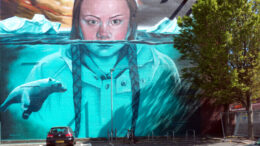In the last year a series of open calls, panels, film festivals and magazine articles have signaled a rising tide of awareness about the vital connection between climate action and art. As a climate artivist — an artist combining creative practice and climate advocacy — these fill me with both hope and frustration.
I’m filled with hope because climate change is a crisis of imagination that needs artists to reclaim the creativity beaten out of us by the same extractive systems that are making our planet and people sick. A crisis is a turning point in a disease; here it’s the turning point we need for mass climate action.
Art can help us to dream the world we want, to remember our Earth roots, to grieve our losses, to celebrate life amidst it all, to resist greenwashed perceptions of climate apathy, to heal our interconnected web of life, and to create just climate futures.
Artists have long helped inspire and mobilize individual and collective action. From the Civil Rights Era to the AIDS crisis to the Black Lives Matter Movement to the recent Covid-19 pandemic, art has helped channel feelings, spread the message, and galvanize action. Today the climate movement needs artists more than ever before.
View this post on Instagram
Despite the scientific consensus on the need to phase out fossil fuels to avoid the most catastrophic consequences of climate change, the latest federal data show an increasing number of oil and gas drilling permits in the United States. In the face of this mammoth bipartisan failure, we need to integrate art with fossil resistance.
Art raises awareness, sometimes through courting controversy. For example, in 2022, climate activists from organizations like Just Stop Oil and Extinction Rebellion desecrated artworks in galleries around the world. The protests were their own kind of synchronized performance art. Whether artists and the art world like it or not, such sensational protests catch our short attention spans: Our planet is burning. Our leaders keep digging us ever deeper into the climate hole.
But these actions are no replacement for the patient work of participatory artivism that mobilizes communities, as in the case of the anti-coal movement in California. A 2021 qualitative study investigated artivism’s role in resisting the construction of a coal-export terminal in California. It found that art had played a decisive role in growing the campaign’s demographic reach and influencing key decision-makers. By engaging poets, musicians, dancers and visual artists in ways that spoke to diverse aesthetics and community spaces, and in doing so from the beginning of the campaign, the organizers effectively engaged women and youth of color.
Art is more than a means of expressing resistance. It is essential for breaking our flight or freeze response to climate angst and for stepping into our own agency to create solutions for ourselves and those disproportionately affected by climate disruptions.
A study in an American Psychological Association Journal evaluated the psychological effects of climate art on spectators. It found that while the use of dystopian elements can catch initial attention, it’s art that offers solutions, and artworks that emphasize the beauty and interconnectedness of nature, that have the most emotional and cognitive impact on viewers to encourage climate action.
View this post on Instagram
To be sure, art alone will not solve the climate crisis. We need to break out of our bubbles. We need to expand our imagination to weave interdisciplinary artistic collaborations with frontline activists, climate scientists, behavior change researchers, policy advocates and lawmakers.
Seeing my climate and art worlds coming together gives me hope. Yet it’s frustrating when — as happened last year — climate activists convene a lengthy panel on the role of artists without having a single artist participate in the discussion. (And no, putting an evocative art by an artist of color on your invitation is not enough.)
It’s frustrating when the leader of a big environmental advocacy organization opines on the role of artists for making people care about climate change without naming concrete steps his own organization is taking to systemically collaborate with artists.
It’s frustrating to see call after call for donations of art for major climate causes without pausing to consider if perhaps artists have worldly concerns like rent, insurance, or a broken kitchen faucet.
If you’re part of the climate movement, stop treating art as an afterthought relegated to your communications departments and artists as the romanticized subjects of soliloquies. Inspiring a creative climate solutions renaissance begins with the art of change within.
Here are a few places to start as you reimagine ways to foster the climate movement’s relationships of solidarity and mutuality with artists:
Connect with diverse artists: Get to know artists from varied backgrounds and practices in your communities. Invite them to your next climate gathering in ways that honor creative labor. Explore artistic engagement in your shared context. Plant the seeds of a climate art salon, an open mic or residency program to foster cross-pollination of diverse people dreaming, singing, dancing, crying and laughing their way toward climate-just futures together.
Learn about imaginative climate art collectives: Study how Design Science Studio’s global creators (including me) are making art for a regenerative future; The Climate Museum’s first pop-up in Manhattan is blending art, social science and climate action; Gulf Coast Murals is bringing together artists, activists, communities and allies in the Gulf Coast to remember and envision; Art and Climate Initiative is using theater for climate solutions; The Climate Comedy Cohort is engaging comedians in the hottest climate science; and 5millionstrong is building artists’ mass actions to shape our shared future.
Reclaim your creativity: As you foster climate art “out” in the world, be creative in your own life: doodle, play, write a poem, hum your favorite song, move out of your very serious chair. In a burning world, so many of us are burned out and separated from our creative vitality. Art offers possibilities of building bridges that embody our intertwined private, collective and planetary healing.
The opinions expressed above are those of the author and do not necessarily reflect those of The Revelator, the Center for Biological Diversity or their employees.
Previously in The Revelator:
The Extinction Crisis in Watercolor and Oils: Using Art to Save Plants
![]()


